Synthesis and Characterization of Hydroxyapatite Assisted by Microwave-Ultrasound from Eggshells for Use as a Carrier of Forchlorfenuron and In Silico and In Vitro Evaluation
Abstract
:1. Introduction
2. Materials and Methods
2.1. Materials
2.2. Preparation of Eggshell Precursor
2.3. Different Methods of Eggshell Grinding
2.4. Synthesis of Hydroxyapatite (Hap)
2.5. Formation of the Fertilizer Composite Hap-FCF
2.6. Characterization of Hap and Hap-FCF
2.7. In Silico Evaluation
2.8. In Vitro Evaluation
3. Results and Discussion
3.1. Material Characterization
3.1.1. X-Ray Diffraction (XDR)
3.1.2. Fourier-Transform Infrared Spectroscopy (FTIR)
3.1.3. Specific Surface Area (BET)
3.1.4. Zeta Potential (ZP)
3.1.5. Scanning Electron Microscopy (SEM)
3.1.6. Bright-Field Transmission Electron Microscopy (BFTEM)
3.2. In Silico Evaluation Results
3.2.1. Docking Between GA3Ox2 and the Ligands GA3 and FCF
3.2.2. Docking Between IAA7 and the Ligands IAA and FCF
3.2.3. Molecular Dynamics (MD)
3.3. In Vitro Evaluation Results
4. Conclusions
Author Contributions
Funding
Institutional Review Board Statement
Informed Consent Statement
Data Availability Statement
Conflicts of Interest
References
- Li-Chan, E.C.Y.; Kim, H.O. Structure and Chemical Composition of Eggs; John Wiley & Sons: Hoboken, NJ, USA, 2008. [Google Scholar]
- Ravindran, C.; Panayam Parambil Kunnathulli, A.; Kunhikrishnan Maniath, J.; Isloor, A.M. Fabrication of eggshell derived hydroxyapatite polymer composite membrane for efficient removal of thorium ions from aqueous solutions. In Materials Today: Proceedings; Elsevier Ltd.: Amsterdam, The Netherlands, 2020; Volume 43, pp. 2140–2149. [Google Scholar] [CrossRef]
- Khandelwal, H.; Prakash, S. Synthesis and Characterization of Hydroxyapatite Powder by Eggshell. J. Miner. Mater. Charact. Eng. 2016, 4, 119–126. [Google Scholar] [CrossRef]
- Rivera, E.M.; Araiza, M.; Brostow, W.; Castaño, V.M.; Díaz-Estrada, J.; Hernández, R.; Rodríguez, J. Synthesis of Hydroxyapatite from Eggshells. Mater. Lett. 1999, 41, 128–134. [Google Scholar] [CrossRef]
- Juárez Robles, D.E.; Salas Avalos, N.S.; Chávez García, M.D.; García Mejía, T.A. Síntesis de Nano-Hidroxiapatita Por Los Métodos Sol-Gel y Coprecipitación; Universidad Autónoma Metropolitana: Mexico City, Mexico, 2017. [Google Scholar]
- de Lima, K.A.; Fernandes, E.F.d.S.; Pacheco, N.I.; Aguiar, E.S.; Lopes, D.C.; Mendes, L.A.P.P.F. Uma breve revisão sobre a hidroxiapatita: Uma biocerâmica promissora. Res. Soc. Dev. 2022, 11, e26411124767. [Google Scholar] [CrossRef]
- Repositorio, E.L. Repositorio Institucional Unasam Formato de Autorización para Publicación de Tesis y Trabajos de Investigación, Para a Optar Grados Académicos y Títulos Profesionales. Available online: https://www.google.com.hk/url?sa=t&source=web&rct=j&opi=89978449&url=https://investigacion.unasam.edu.pe/archivos/documentos/publicaciones/norma_9.docx&ved=2ahUKEwiBw-qY-5mKAxWEbvUHHaw8EwIQFnoECB8QAQ&usg=AOvVaw0vG8h9eez_dSQiWKjjmKBh (accessed on 2 December 2024).
- Cuesta, G.; Mondaca, E. Effect of an auxin-based bioregulator on growth of tomato seedlings. Rev. Chapingo Ser. Hortic. 2014, 20, 215–222. [Google Scholar] [CrossRef]
- Fisiología, Y.; Producción Vegetal, M.E.; Aranda González, P. Pontificia Universidad Católica de Chile Facultad de Agronomia e Ingenieria Forestal Dirección de Postgrado e Investigación. Available online: https://www.biologiachile.cl/biological_research/VOL44_2011/SupA/01_Biological_suplemento_interior.pdf (accessed on 12 November 2024).
- Maoz, I.; Bahar, A.; Kaplunov, T.; Zutchi, Y.; Daus, A.; Lurie, S.; Lichter, A. Effect of the cytokinin forchlorfenuron on tannin content of thompson seedless table grapes. Am. J. Enol. Vitic. 2014, 65, 230–237. [Google Scholar] [CrossRef]
- Garzón-Pérez, A.S.; Paredes-Carrera, S.P.; Martínez-Gutiérrez, H.; Cayetano-Castro, N.; Sánchez-Ochoa, J.C.; Pérez-Gutiérrez, R.M. Effect of combined microwave-ultrasound irradiation in the structure and morphology of hydrotalcite like compounds al/mg-ch3coo andits evaluation in the sorption of a reactive dye. Rev. Mex. Ing. Quim. 2020, 19, 363–375. [Google Scholar] [CrossRef]
- Salinas-Estevané, P.; Sánchez Cervantes, E.M. La Química Verde en la Síntesis de Nanoestructuras. Ingenierías 2012, 15, 7–16. [Google Scholar]
- De, U.; De, S.; En, A.; Analítica, R. Evaluación In Silico de las Interacciones Ligando-Receptor de Una Serie de Isoindolinas Derivadas de Aminoácidos y el Receptor del Ácido Gamma Aminobutírico Subtipo A (GABAA); Universidad Veracruzana: Xalapa, Mexico, 2018. [Google Scholar]
- Ballón Paucara, W.G.; Grados Torrez, R.E. Acomplamiento Molecular: Criterios Prácticos Para La Selección de Ligandos Biológicamente Activos e Identificación de Nuevos Blancos Terapéuticos. Rev. Con-Cienc. 2019, 7, 55–72. [Google Scholar]
- Arredondo-Tamayo, B.; Méndez-Méndez, J.V.; Chanona-Pérez, J.J.; Hernández-Varela, J.D.; González-Victoriano, L.; Gallegos-Cerda, S.D.; Martínez-Mercado, E. Study of Gellan Gum Films Reinforced with Eggshell Nanoparticles for the Elaboration of Eco-Friendly Packaging. Food Struct. 2022, 34, 100297. [Google Scholar] [CrossRef]
- Kim, S.; Chen, J.; Cheng, T.; Gindulyte, A.; He, J.; He, S.; Li, Q.; Shoemaker, B.A.; Thiessen, P.A.; Yu, B.; et al. PubChem 2023 update. Nucleic Acids Res. 2023, 51, D1373–D1380. [Google Scholar] [CrossRef]
- Berman, H.M.; Westbrook, J.; Feng, Z.; Gilliland, G.; Bhat, T.N.; Weissig, H.; Shindyalov, I.N.; Bourne, P.E. The Protein Data Bank. Nucleic Acids Res. 2000, 28, 235–242. [Google Scholar] [CrossRef] [PubMed]
- Hanwell, M.D.; Curtis, D.E.; Lonie, D.C.; Vandermeersch, T.; Zurek, E.; Hutchison, G.R. SOFTWARE Open Access Avogadro: An Advanced Semantic Chemical Editor, Visualization, and Analysis Platform. J. Cheminform. 2012, 4, 17. [Google Scholar] [CrossRef] [PubMed]
- Pettersen, E.F.; Goddard, T.D.; Huang, C.C.; Couch, G.S.; Greenblatt, D.M.; Meng, E.C.; Ferrin, T.E. UCSF Chimera—A visualization system for exploratory research and analysis. J. Comput. Chem. 2004, 25, 1605–1612. [Google Scholar] [CrossRef]
- Eberhardt, J.; Santos-Martins, D.; Tillack, A.F.; Forli, S. AutoDock Vina 1.2.0: New Docking Methods, Expanded Force Field, and Python Bindings. J. Chem. Inf. Model. 2021, 61, 3891–3898. [Google Scholar] [CrossRef]
- Trott, O.; Olson, A.J. AutoDock Vina: Improving the speed and accuracy of docking with a new scoring function, efficient optimization, and multithreading. J. Comput. Chem. 2010, 31, 455–461. [Google Scholar] [CrossRef]
- Morris, G.M.; Huey, R.; Lindstrom, W.; Sanner, M.F.; Belew, R.K.; Goodsell, D.S.; Olson, A.J. Software news and updates AutoDock4 and AutoDockTools4: Automated docking with selective receptor flexibility. J. Comput. Chem. 2009, 30, 2785–2791. [Google Scholar] [CrossRef] [PubMed]
- Hess, B.; Kutzner, C.; Van Der Spoel, D.; Lindahl, E. GRGMACS 4: Algorithms for highly efficient, load-balanced, and scalable molecular simulation. J. Chem. Theory Comput. 2008, 4, 435–447. [Google Scholar] [CrossRef]
- Brooks, B.R.; Brooks, C.L., III; MacKerell, A.D., Jr.; Nilsson, L.; Petrella, R.J.; Roux, B.; Won, Y.; Archontis, G.; Bartels, C.; Boresch, S.; et al. CHARMM: The biomolecular simulation program. J. Comput. Chem. 2009, 30, 1545–1614. [Google Scholar] [CrossRef]
- Gao, C.; Zhao, K.; Lin, L.; Wang, J.; Liu, Y.; Zhu, P. Preparation and characterization of biomimetic hydroxyapatite nanocrystals by using partially hydrolyzed keratin as template agent. Nanomaterials 2019, 9, 241. [Google Scholar] [CrossRef]
- Lucero, V.; Córdova, Z. Metodología Para La Fabricación de Andamios Porosos de Hidroxiapatita y Fluorapatita Mediante Lixiviación de Sales. Bachelor’s Thesis, Universidad Autónoma de Baja California, Tijuana, Mexico, 2016. [Google Scholar]
- AB Martínez-Valencia, H.; Esparza-Ponce, E.; Ortiz-Landeros, J. Caracterización estructural y morfológica de hidroxiapatita nanoestructurada: Estudio comparativo de diferentes métodos de síntesis. Superf. Vacío 2008, 21, 18–21. [Google Scholar]
- Prakash, K.H.; Kumar, R.; Ooi, C.P.; Cheang, P.; Khor, K.A. Apparent solubility of hydroxyapatite in aqueous medium and its influence on the morphology of nanocrystallites with precipitation temperature. Langmuir 2006, 22, 11002–11008. [Google Scholar] [CrossRef]
- Inoue, Y.; Hirano, A.; Murata, I.; Kobata, K.; Kanamoto, I. Assessment of the Physical Properties of Inclusion Complexes of Forchlorfenuron and γ-Cyclodextrin Derivatives and Their Promotion of Plant Growth. ACS Omega 2018, 3, 13160–13169. [Google Scholar] [CrossRef] [PubMed]
- Hernández-Navarro, C.; Díaz-león, J.L.; Louvier-Hernández, J.F.; Vázquez-López, J.A.; García-Bustos, E.; Flores-Flores, T.C.; Quintana-Hernández, P.A. Preparación y Caracterización de Un Composito de Tipo PVA/HAp. Mem. Congr. Nac. Ing. Bioméd. 2018, 5, 310–313. [Google Scholar]
- Vargas-Becerril, N.; Sánchez-Téllez, D.A.; Zarazúa-Villalobos, L.; González-García, D.M.; Álvarez-Pérez, M.A.; de León-Escobedo, C.; Téllez-Jurado, L. Structure of biomimetic apatite grown on hydroxyapatite (HA). Ceram. Int. 2020, 46 Part A, 28806–28813. [Google Scholar] [CrossRef]
- Zhou, H.; Yang, Y.; Yang, M.; Wang, W.; Bi, Y. Synthesis of mesoporous hydroxyapatite via a vitamin C templating hydrothermal route. Mater. Lett. 2018, 218, 52–55. [Google Scholar] [CrossRef]
- Muthu, D.; Kumar, G.S.; Gowri, M.; Prasath, M.; Viswabaskaran, V.; Kattimani, V.; Girija, E. Rapid synthesis of eggshell derived hydroxyapatite with nanoscale characteristics for biomedical applications. Ceram. Int. 2022, 48, 1326–1339. [Google Scholar] [CrossRef]
- Han, K.S.; Sathiyaseelan, A.; Saravanakumar, K.; Wang, M.H. Wound healing efficacy of biocompatible hydroxyapatite from bovine bone waste for bone tissue engineering application. J. Environ. Chem. Eng. 2022, 10, 106888. [Google Scholar] [CrossRef]
- Gusmão, S.B.S.; Ghosh, A.; de Menezes, A.S.; Pereira, A.F.M.; Lopes, M.T.P.; Souza, M.K.; Dittz, D.; Abreu, G.J.P.; Pinto, L.S.S.; Filho, A.L.M.M.; et al. Nanohydroxyapatite/Titanate Nanotube Composites for Bone Tissue Regeneration. J. Funct. Biomater. 2022, 13, 306. [Google Scholar] [CrossRef]
- Ren, Y.; Xiang, P.; Xie, Q.; Yang, H.; Liu, S. Rapid analysis of forchlorfenuron in fruits using molecular complex-based dispersive liquid–liquid microextraction. Food Addit. Contam. Part A Chem. Anal. Control Expo. Risk Assess. 2021, 38, 637–645. [Google Scholar] [CrossRef]
- Obregón, D. Estudio Comparativo de la Capacidad de Adsorción de Cadmio Utilizando Carbones Activados Preparados a Partir de Semillas de Aguaje y de Aceituna. Bachelor’s Thesis, Pontifical Catholic University of Peru, San Miguel, Peru, 2012. [Google Scholar] [CrossRef]
- Laura de la Vega-García, N.; Beatriz Peña-Valdivia, C.; del Carmen González-Chávez, M.A.; Padilla-Chacón, D.; Carrillo-González, R. Síntesis y Efecto de Nanopartículas de Hidroxiapatita en la Germinación y Crecimiento de Frijol Synthesis and Effect of Hydroxyapatite Nanoparticles on the Germination and Growth of Common Bean. Agrociencia 2020, 54, 1009–1029. [Google Scholar] [CrossRef]
- Pamela Agredo Sanín. Caracterización Fisicoquímica de Emulsiones Tipo O/W Estabilizadas Mediante Diferentes Mezclas de Surfactantes Catiónicos Monoméricos Y Poliméricos; Universidad Icesi: Cali, Colombia, 2017; Available online: https://repository.icesi.edu.co/biblioteca_digital/bitstream/10906/83426/1/T01254.pdf (accessed on 25 March 2024).
- Venkateswarlu, K.; Bose, A.C.; Rameshbabu, N. X-ray peak broadening studies of nanocrystalline hydroxyapatite by WilliamsonHall analysis. Phys. B Condens. Matter. 2010, 405, 4256–4261. [Google Scholar] [CrossRef]
- Paraguay-Delgado, F. Técnicas de microscopía electrónica usadas en el estudio de nanopartículas. Mundo Nano Rev. Interdiscip. Nanocienc. Nanotecnol. 2020, 13, 101–131. [Google Scholar] [CrossRef]
- Foster, A. Practical_Plant_Anatomy; Van Nostrand: New York City, NY, USA, 1949; pp. 142–143. [Google Scholar]
- Tyler, G.; Zohlen, A. Plant Seeds as Mineral Nutrient Resource for Seedlings-A Comparison of Plants from Calcareous and Silicate Soils. Ann. Bot. 1998, 81, 455–459. [Google Scholar] [CrossRef]
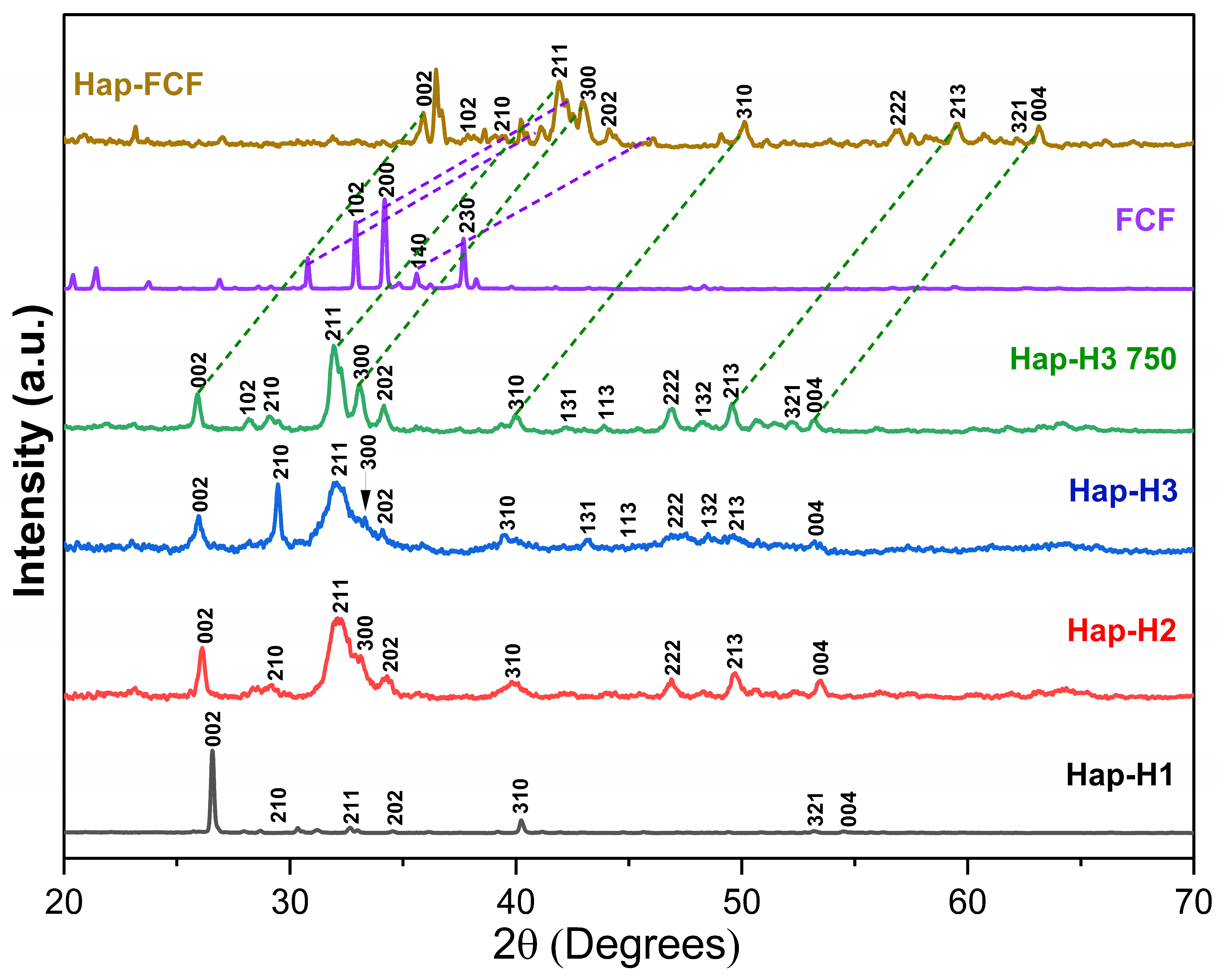
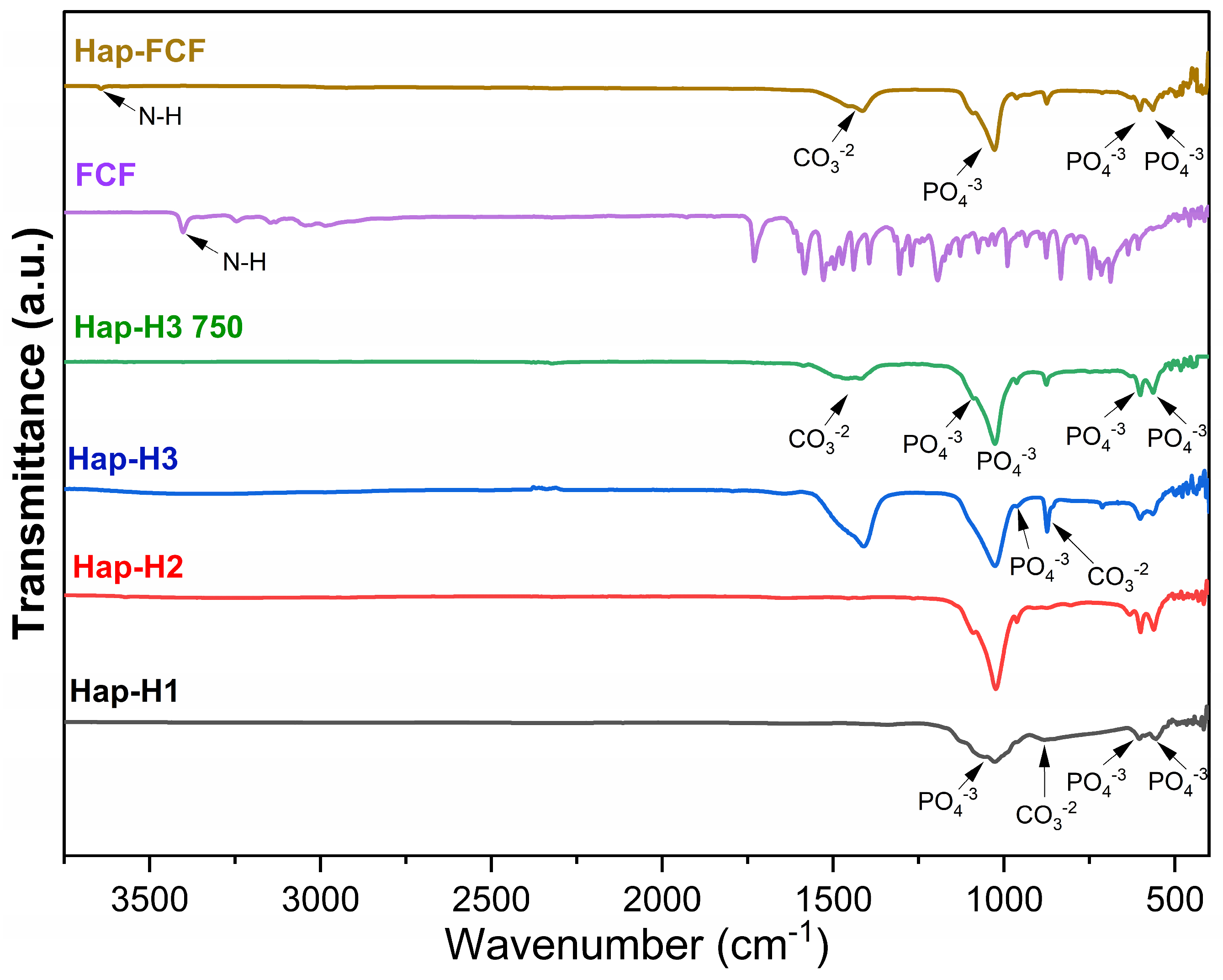
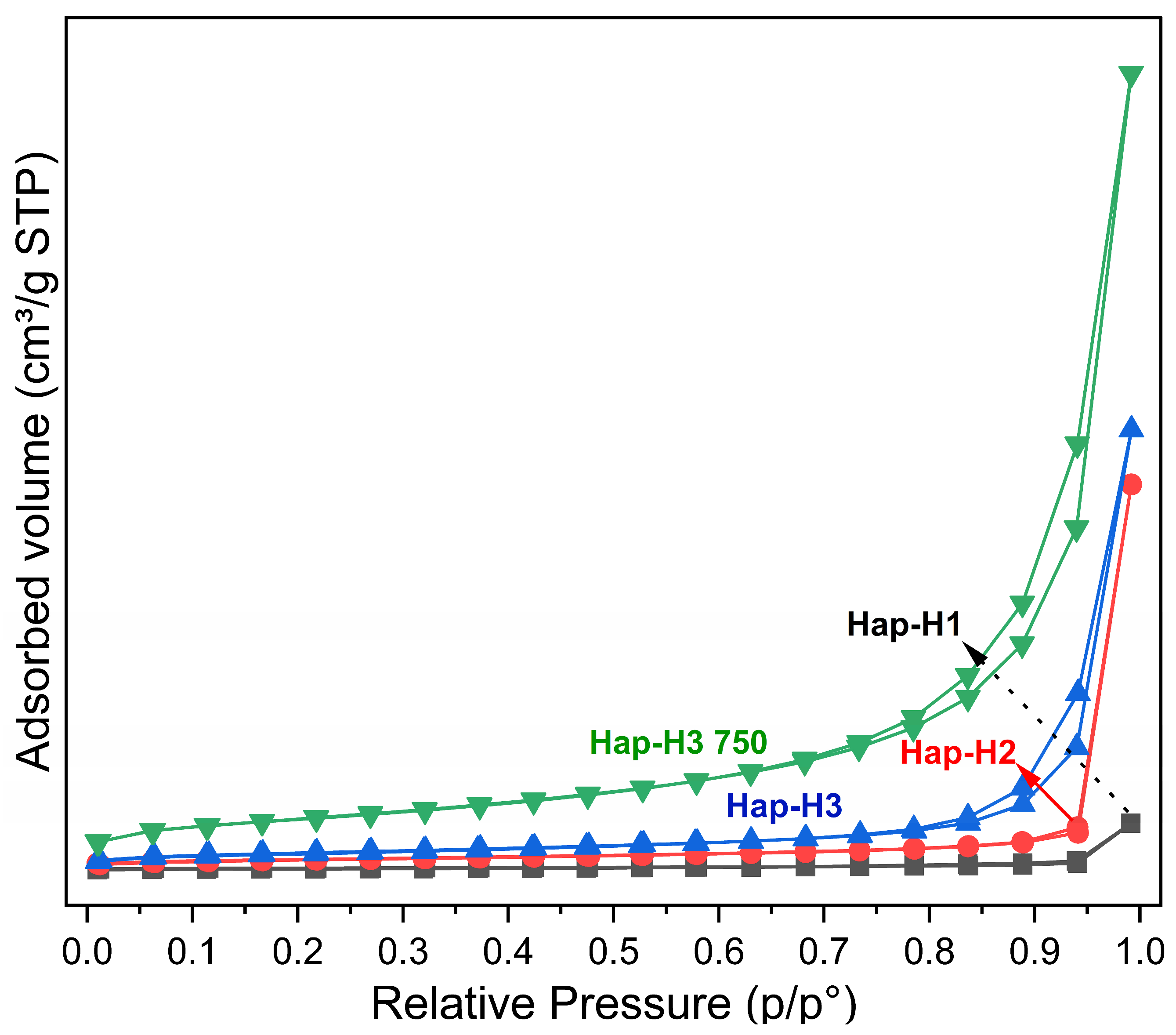
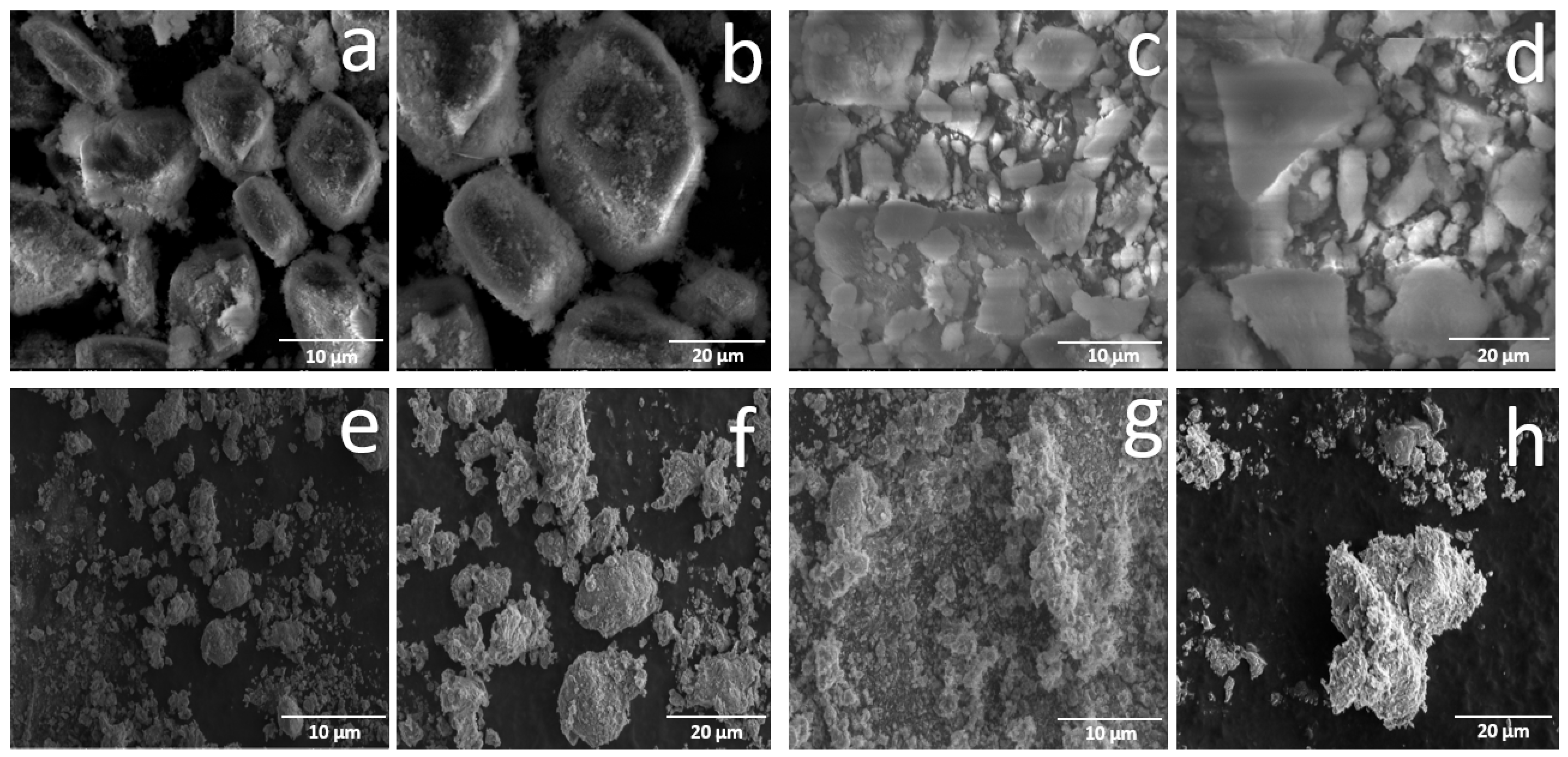
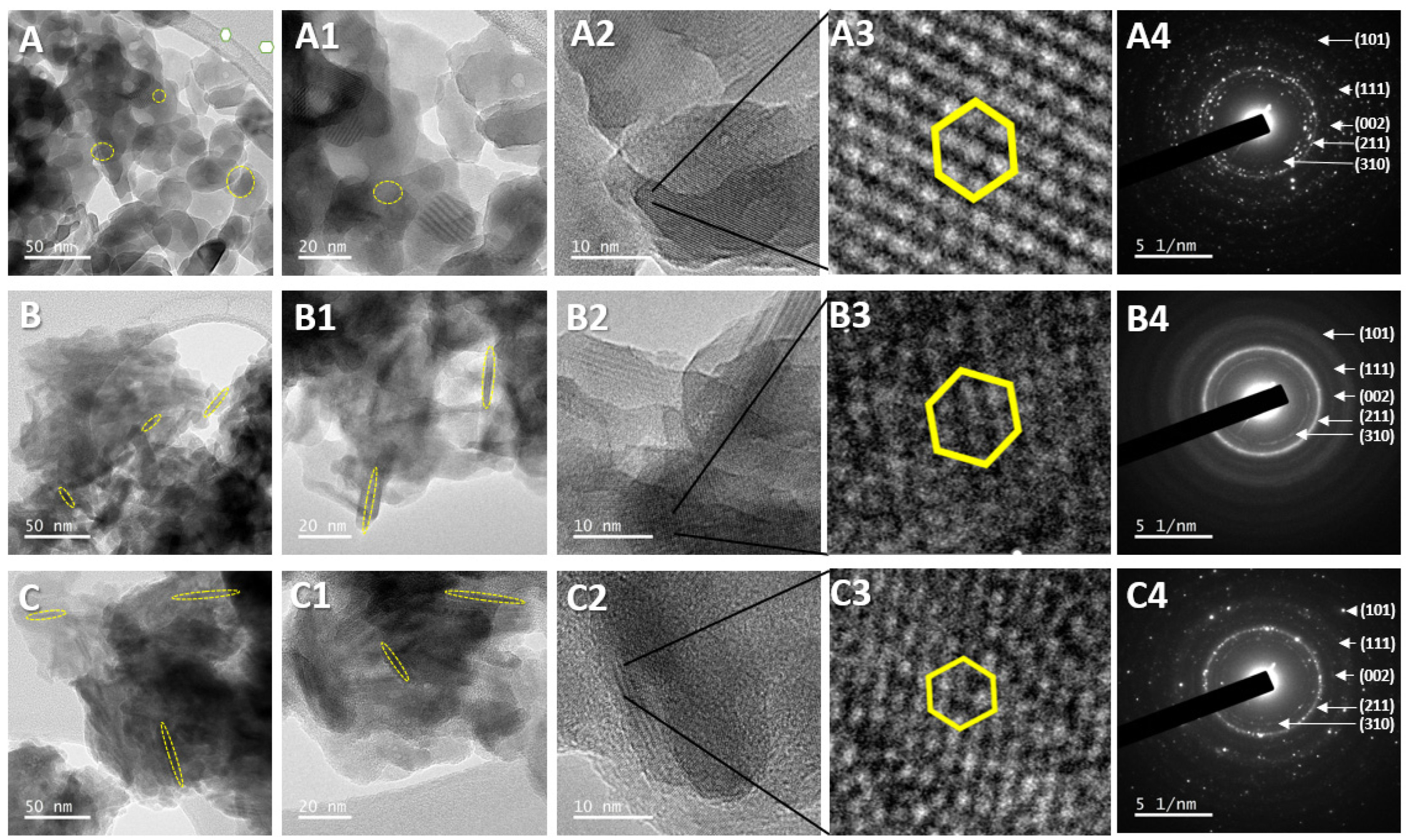
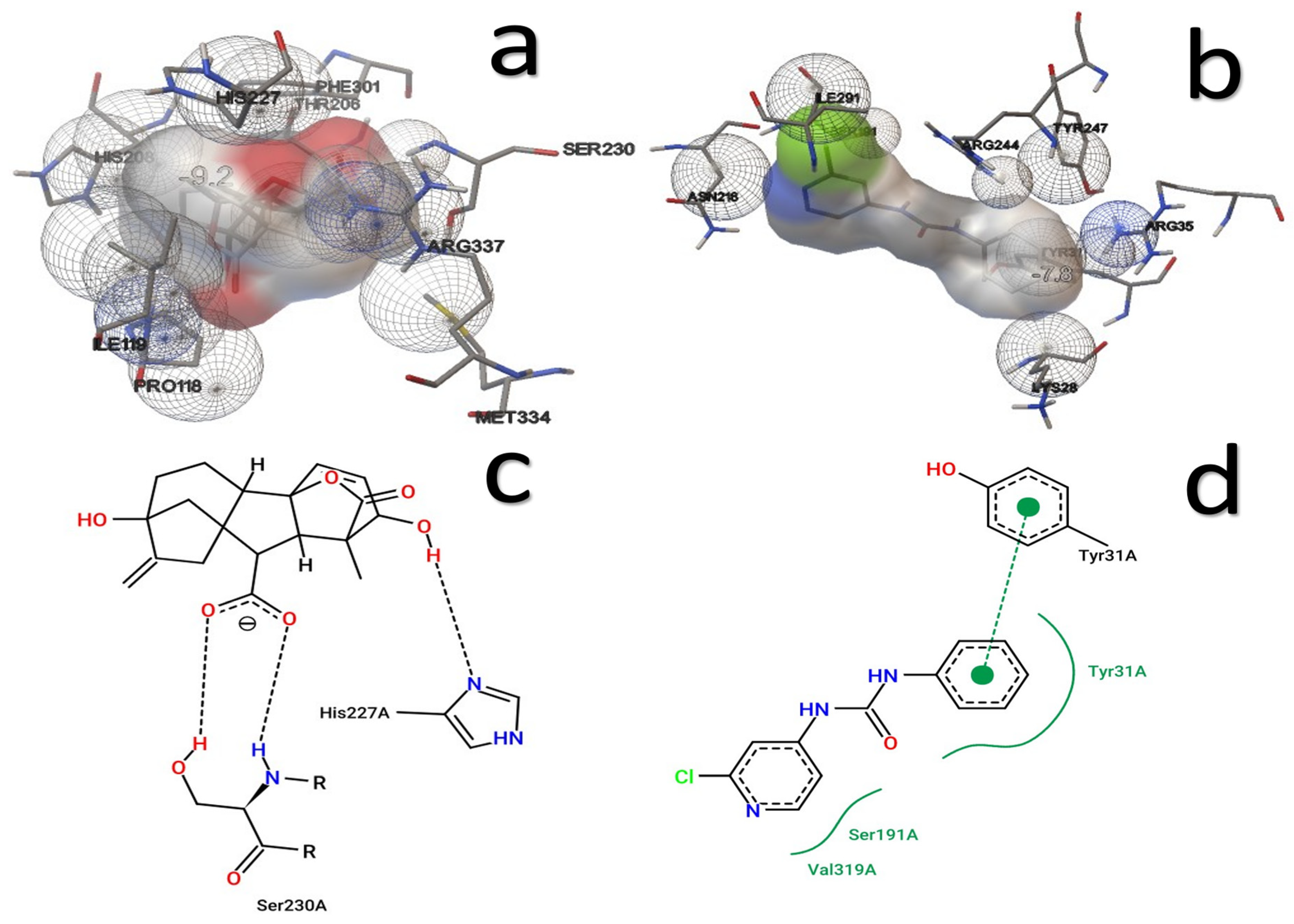


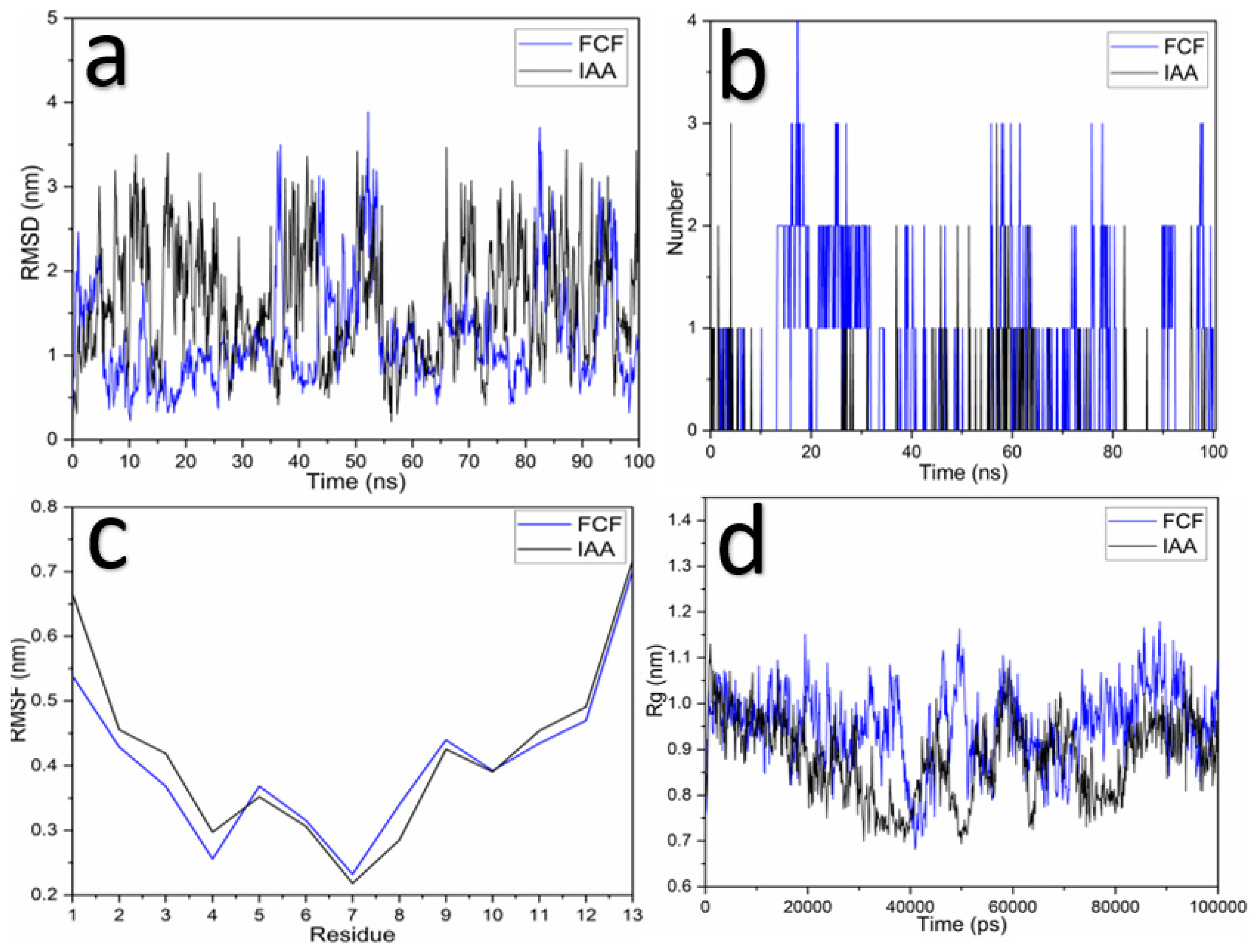
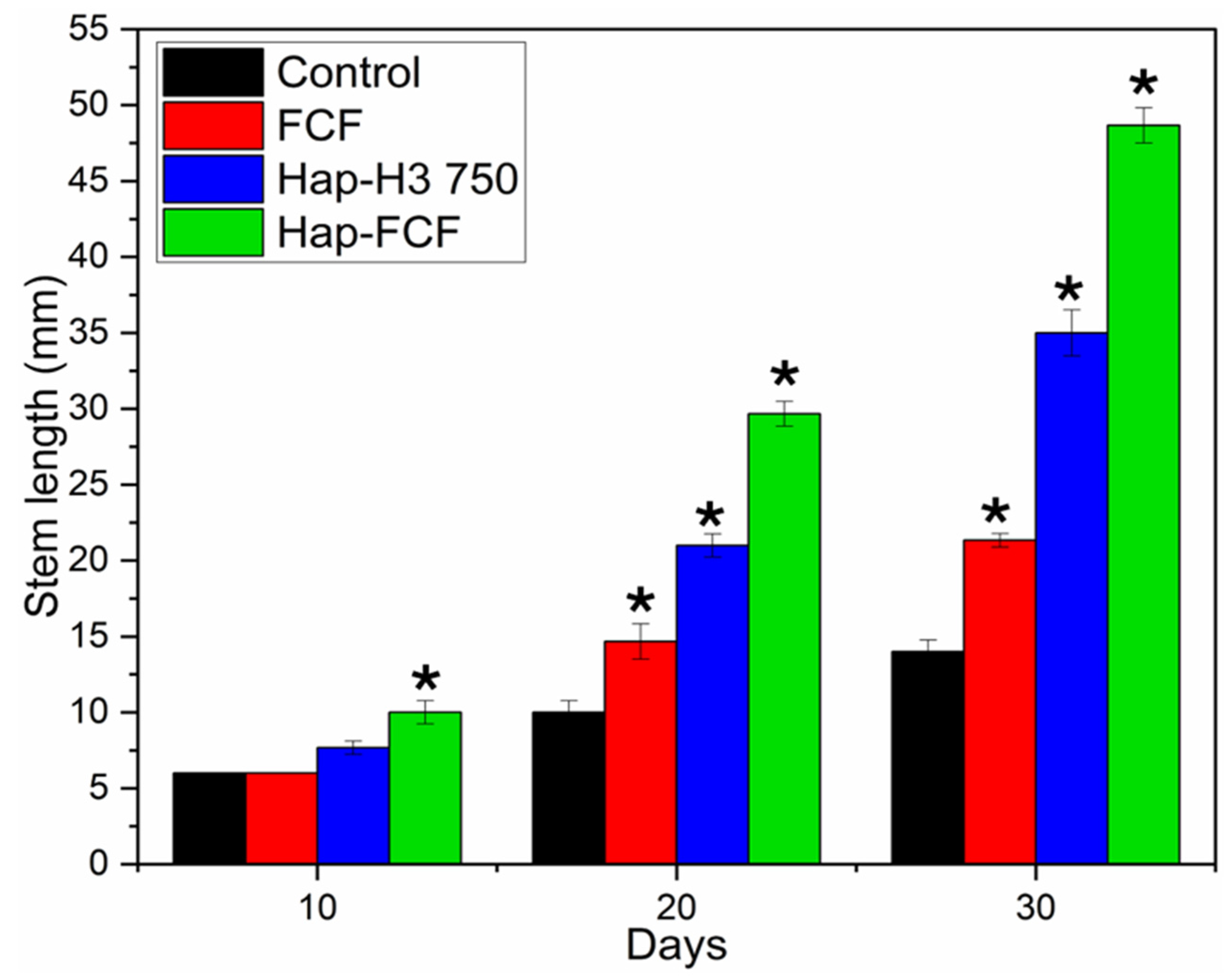

| ID Sample | SBET (m2/g) | Pore Volume BJH (cm3/g) | Pore Diameter BJH (nm) |
|---|---|---|---|
| Hap-H1 | 4.51 | 0.05 | 35.16 |
| Hap-H2 | 24.72 | 0.41 | 36.73 |
| Hap-H3 | 41.46 | 0.47 | 31.63 |
| Hap-H3 750 | 128.41 | 0.86 | 20.95 |
| ID Sample | ZP (mV) |
|---|---|
| Hap-H1 | −18.6 |
| Hap-H2 | −19.1 |
| Hap-H3 | −21.9 |
| Hap-H3 750 | −22.6 |
| Hap-FCF | −22.8 |
| Receptor | Ligand | Affinity Energy (kcal/mol) | Amino Acid of Interaction |
|---|---|---|---|
| GA3Ox2 | GA3 | −9.2 | HIS208, HIS227, PHE310, THR206, SER230, ARG337, ILE119, PRO118, MET334 |
| FCF | −7.8 | ASN210, ARG295, ASP229, HIS227, ILE119, LEU224, PHE301, SER297, TYR212, VAL236 | |
| IAA7 | IAA | −5.0 | ARG12, LYS13, PRO6, ASN10, TYR11 |
| FCF | −5.4 | ARG12, LYS13, VAL8, ASN10 |
| Day | Control | FCF | HAP-H3 750 | Hap-FCF |
|---|---|---|---|---|
| 0 |  |  |  |  |
| 10 |  |  |  |  |
| 20 |  |  |  |  |
| 30 |  |  |  |  |
Disclaimer/Publisher’s Note: The statements, opinions and data contained in all publications are solely those of the individual author(s) and contributor(s) and not of MDPI and/or the editor(s). MDPI and/or the editor(s) disclaim responsibility for any injury to people or property resulting from any ideas, methods, instructions or products referred to in the content. |
© 2024 by the authors. Licensee MDPI, Basel, Switzerland. This article is an open access article distributed under the terms and conditions of the Creative Commons Attribution (CC BY) license (https://creativecommons.org/licenses/by/4.0/).
Share and Cite
Romero-De La Rosa, B.I.; Paredes-Carrera, S.P.; Mendoza-Pérez, J.A.; Nicolás-Álvarez, D.E.; Garibay-Febles, V.; Camacho-Olguin, C.A. Synthesis and Characterization of Hydroxyapatite Assisted by Microwave-Ultrasound from Eggshells for Use as a Carrier of Forchlorfenuron and In Silico and In Vitro Evaluation. Appl. Sci. 2024, 14, 11522. https://doi.org/10.3390/app142411522
Romero-De La Rosa BI, Paredes-Carrera SP, Mendoza-Pérez JA, Nicolás-Álvarez DE, Garibay-Febles V, Camacho-Olguin CA. Synthesis and Characterization of Hydroxyapatite Assisted by Microwave-Ultrasound from Eggshells for Use as a Carrier of Forchlorfenuron and In Silico and In Vitro Evaluation. Applied Sciences. 2024; 14(24):11522. https://doi.org/10.3390/app142411522
Chicago/Turabian StyleRomero-De La Rosa, Benjamín I., Silvia P. Paredes-Carrera, Jorge A. Mendoza-Pérez, Dulce E. Nicolás-Álvarez, Vicente Garibay-Febles, and Carlos A. Camacho-Olguin. 2024. "Synthesis and Characterization of Hydroxyapatite Assisted by Microwave-Ultrasound from Eggshells for Use as a Carrier of Forchlorfenuron and In Silico and In Vitro Evaluation" Applied Sciences 14, no. 24: 11522. https://doi.org/10.3390/app142411522
APA StyleRomero-De La Rosa, B. I., Paredes-Carrera, S. P., Mendoza-Pérez, J. A., Nicolás-Álvarez, D. E., Garibay-Febles, V., & Camacho-Olguin, C. A. (2024). Synthesis and Characterization of Hydroxyapatite Assisted by Microwave-Ultrasound from Eggshells for Use as a Carrier of Forchlorfenuron and In Silico and In Vitro Evaluation. Applied Sciences, 14(24), 11522. https://doi.org/10.3390/app142411522





